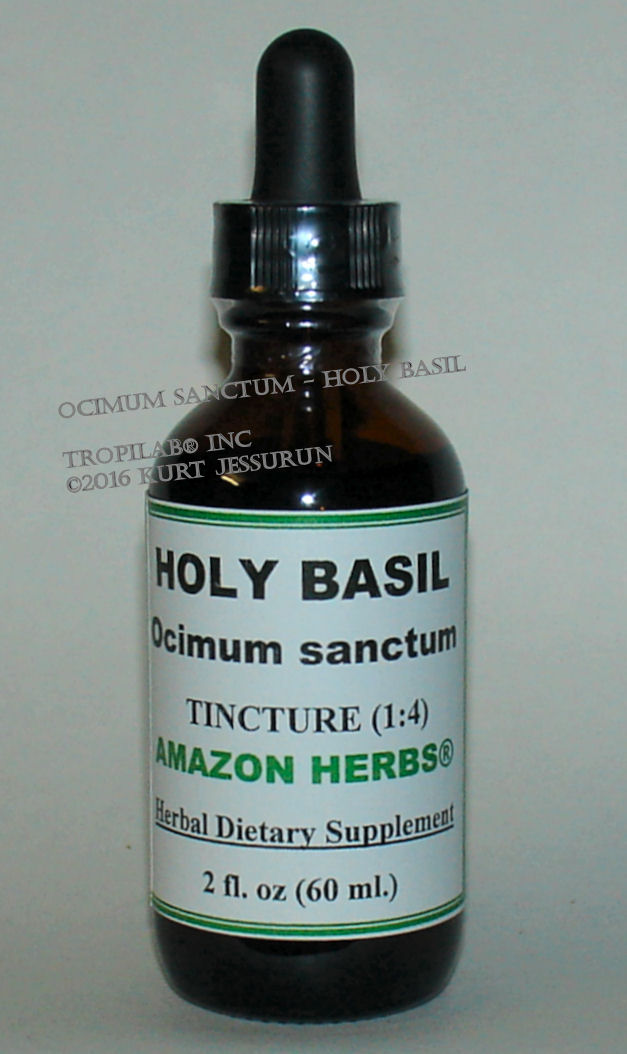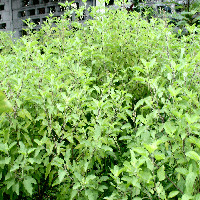 Overview
Overview
Holy basil (Tulsi), an herb native to India, is regarded as one of the most important plants used in
Ayurvedic medicine.
It is an erect, much branched sub-shrub 40 - 90 cm tall with hairy stems and simple opposite green leaves that are strongly scented.
Traditionally it is used in bronchial asthma, diarrhea, dysentery, skin diseases, malarial fevers, gastric disorders and in hepatic
infections.
The leaves are used against bronchitis, ringworm (external) and earache.
It has excellent antioxidant, antibacterial, antiviral, adaptogenic (improves the body’s ability to adept to
stress) and immune-enhancing properties. It promotes general health and supports the body's natural defense
against stress and illness.
It seems to increases endurance, inhibits ulcer formation, and protects against gamma radiation. The leaves may
improve pancreatic beta cell function and enhance insulin secretion.
An herbal tincture and infusion (medicinal tea) of the dried whole plant is made. Pharmacological studies have
established a scientific basis for important therapeutic uses of this plant.
Constituents
Essential oils (eugenol, methyl eugenol, caryophyllene); sesquiterpenes & monoterpenes
viz., bornyl acetate, ß-elemene, methyleugenol, neral, ß-pinene, camphene, a-pinene etc, ursolic acid,
campesterol, cholesterol, stigmasterol, ß-sitosterol and methyl esters of common fatty acids.
Three new compounds, ocimumosides A (1) and B (2) and ocimarin (3) Eugenol (1-hydroxy-2-methoxy-4-allylbenzene),
the active constituent present in Ocimum sanctum L., has been found to be largely responsible for the therapeutic
potentials of Holy basil.
Pharmacology
 Recent studies suggest that Tulsi may be a COX-2 inhibitor, like many modern painkillers,
due to the high concentration of eugenol, aka Clove oil (1-hydroxy-2-methoxy-4-allylbenzene) in it.
Recent studies suggest that Tulsi may be a COX-2 inhibitor, like many modern painkillers,
due to the high concentration of eugenol, aka Clove oil (1-hydroxy-2-methoxy-4-allylbenzene) in it.
One study showed it to be an effective treatment for diabetes by reducing blood glucose levels. The
same study showed significant reduction in total cholesterol levels when using Holy basil.
Another study showed the beneficial effect on blood glucose levels is due to its antioxidant properties. Holy basil
also shows some promise for protection from radiation poisoning and cataracts.
The alcoholic leaf extract of Ocimum sanctum was tested for analgesic activity. The results of the study suggest that
the analgesic action is exerted both centrally as well as peripherally and involves interplay between various neurotransmitter
systems.
The protective effect of the ethanolic leaf extract of Ocimum sanctum on haloperidol induced catalepsy was evaluated. The results
suggest that Ocimum has a protective effect against haloperidol-induced catalepsy (a trance-like state marked by loss of voluntary
motion), which is comparable to the standard drugs Scopolamine and Ondansetron (Zofran) used for the same purpose. The study
indicates that Holy basil could be used to prevent drug-induced extrapyramidal side effects. These are the effects associated with
improper dosing of/or unusual reactions to neuroleptic (antipsychotic) medication.
Ocimum sanctum leaves have been reported to reduce blood glucose when administered humans with diabetes.
Findings indicate that constituents of O. sanctum leaf extracts have stimulatory effects on physiological pathways
of insulin secretion which may underlie its reported antidiabetic action.
A new class of drugs (nootropic agents) is now used in situations where there is organic disorder in learning abilities.
O. sanctum preparations could be beneficial in the treatment of cognitive disorders such as dementia and Alzheimer's
disease.
Applications
Anti-inflammatory, expectorant, analgesic, anti-tumor & antibacterial.
Dosage
Tincture: 1 - 2 ml, two times daily
Infusion (herbal tea): 1 - 2 cups daily
Side effects
Not recommended in pregnant or breastfeeding women.
Holy basil may stimulate uterine contractions.
Reference
Anticancer Activity of Ocimum Sanctum
Karthikeyan K.; Gunasekaran P.; Ramamurthy N.; Govindasamy S.
Pharmaceutical Biology (Formerly International Journal of Pharmacognosy), Vol. 37, No 4, Oct 1999; pp. 285-290
Ocimum sanctum leaf extracts stimulate insulin secretion from perfused pancreas, isolated islets and clonal pancreatic
ß-cells.
J M A Hannan, L Marenah, L Ali¹, B Rokeya¹, P R Flatt and Y H A Abdel-Wahab
Diabetes Research Group, School of Biomedical Sciences, University of Ulster, Coleraine, Northern Ireland BT52 1SA, UK
¹ Department of Pharmacology, Biomedical Research Group, BIRDEM, Dhaka-1000, Bangladesh
Constituents of Ocimum sanctum with antistress activity.
Gupta P, Yadav DK, Siripurapu KB, Palit G, Maurya R.
Division of Medicinal and Process Chemistry, Central Drug Research Institute, Lucknow, India.
The above presentation is for informational and educational purposes only.
It is based on scientific studies (human, animal, or in vitro), clinical experience, or traditional usage.
For many of the conditions discussed, treatment with prescribed (RX) or over - the - counter medication (OTC) is
also available.
Consult your doctor, practitioner, and/or pharmacist for any health problem and before using dietary supplements
or before making any changes in prescribed medications.
|

